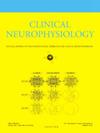舌横波弹性成像诊断肌萎缩性侧索硬化症患者的球功能障碍
IF 3.6
3区 医学
Q1 CLINICAL NEUROLOGY
引用次数: 0
摘要
目的肌萎缩性侧索硬化症(ALS)以累及舌头为主要表现,可导致构音障碍和吞咽困难。虽然目前的诊断方法是侵入性的或定性的,但发展非侵入性的舌头功能定量评估是必不可少的。方法一项前瞻性研究(2022年3月至2024年3月),纳入38例ALS患者(按球或脊柱发病分类)和12例对照组。使用肌萎缩侧索硬化症功能评定量表(ALSFRS-R)评估临床症状。采用剪切波弹性仪(LOGIQ®E9, 9 MHz)测量舌肌弹性。结果球型ALS的颏舌肌中位剪切模量(7.80 kPa,范围5.41 ~ 10.08)明显低于脊柱型ALS (12.48 kPa,范围8.50 ~ 21.42)和对照组(14.16 kPa,范围11.37 ~ 20.21)。膝舌骨肌(GH)表现出类似的形态。与对照组相比,球源性ALS患者两组肌肉的弹性明显降低(p < 0.05)。在ALSFRS-R中,GG肌弹性与球症状严重程度呈强正相关。结论舌肌弹性降低与球茎症状相关,提示该技术在诊断和预后方面的潜在应用价值。这些研究结果表明,横波弹性成像是一种很有前途的无创工具,用于定量评估ALS患者的舌头功能障碍。本文章由计算机程序翻译,如有差异,请以英文原文为准。
Tongue shear wave elastography for bulbar dysfunction in amyotrophic lateral sclerosis
Objective
Amyotrophic lateral sclerosis (ALS) often manifests with tongue involvement, leading to dysarthria and dysphagia. While current diagnostic methods are invasive or qualitative, the development of non-invasive quantitative assessments of tongue function is essential.
Methods
A prospective study (March 2022 − March 2024) included 38 ALS patients (categorized by bulbar or spinal onset) and 12 controls. Clinical symptoms were evaluated using the Amyotrophic Lateral Sclerosis Functional Rating Scale-Revised (ALSFRS-R). Tongue muscle elasticity was measured using shear wave elastography (LOGIQ® E9, 9 MHz).
Results
Median shear modulus of the genioglossus (GG) muscle was significantly lower in bulbar-onset ALS (7.80 kPa, range 5.41–10.08) compared to spinal-onset ALS (12.48 kPa, range 8.50–21.42) and controls (14.16 kPa, range 11.37–20.21). The geniohyoid (GH) muscle showed similar patterns. Both muscles showed significantly reduced elasticity in bulbar-onset ALS compared to controls (p < 0.05). The GG muscle elasticity showed strong positive correlation with bulbar symptom severity on the ALSFRS-R.
Conclusions
Reduced tongue muscle elasticity in bulbar-onset ALS, along with its correlation with bulbar symptoms, suggests the potential utility of this technique for both diagnosis and prognosis.
Signature
These findings indicate that shear wave elastography is a promising noninvasive tool for the quantitative assessment of tongue dysfunction in ALS.
求助全文
通过发布文献求助,成功后即可免费获取论文全文。
去求助
来源期刊

Clinical Neurophysiology
医学-临床神经学
CiteScore
8.70
自引率
6.40%
发文量
932
审稿时长
59 days
期刊介绍:
As of January 1999, The journal Electroencephalography and Clinical Neurophysiology, and its two sections Electromyography and Motor Control and Evoked Potentials have amalgamated to become this journal - Clinical Neurophysiology.
Clinical Neurophysiology is the official journal of the International Federation of Clinical Neurophysiology, the Brazilian Society of Clinical Neurophysiology, the Czech Society of Clinical Neurophysiology, the Italian Clinical Neurophysiology Society and the International Society of Intraoperative Neurophysiology.The journal is dedicated to fostering research and disseminating information on all aspects of both normal and abnormal functioning of the nervous system. The key aim of the publication is to disseminate scholarly reports on the pathophysiology underlying diseases of the central and peripheral nervous system of human patients. Clinical trials that use neurophysiological measures to document change are encouraged, as are manuscripts reporting data on integrated neuroimaging of central nervous function including, but not limited to, functional MRI, MEG, EEG, PET and other neuroimaging modalities.
 求助内容:
求助内容: 应助结果提醒方式:
应助结果提醒方式:


